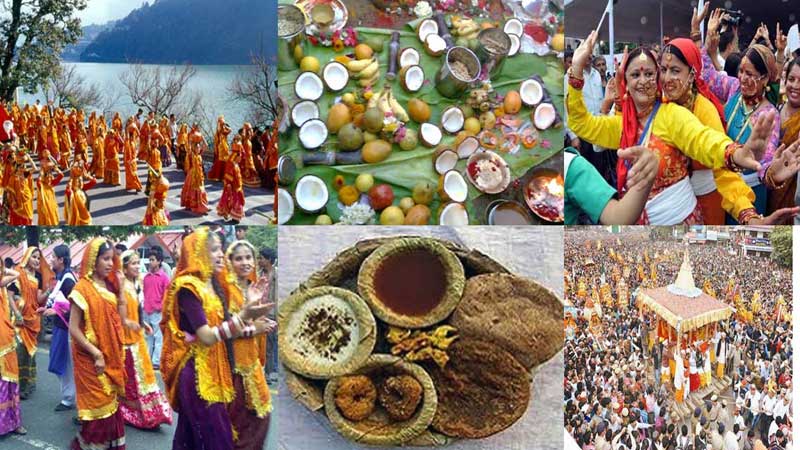Kumaon and Garhwal’s Cultural
Uttarakhand shares its borders with Tibet (China) in the north and Nepal in the east. Internally, the state is divided into:
- Garhwal in the west
- Kumaon in the east
The Himalayas, dense forests, river valleys, and high-altitude meadows define the geography of both regions. Some of the most important rivers of India, including the Ganga and Yamuna, originate here.
🌄 Kumaon Region
The Kumaon region in the Indian state of Uttarakhand is a land of mesmerizing landscapes, ancient temples, rich culture, and warm-hearted people. Located in the eastern part of the state, Kumaon is a unique blend of natural beauty and cultural heritage, making it one of the most treasured regions in Northern India. From the serene lakes of Nainital to the spiritual temples of Almora and the adventurous terrains of Pithoragarh, Kumaon offers a wide range of experiences for travelers, nature lovers, and pilgrims alike.
Geography and Location
Kumaon lies in the eastern part of Uttarakhand and shares its borders with Nepal to the east, Tibet (China) to the north, and the Garhwal region to the west. It comprises six districts:
- Nainital
- Almora
- Pithoragarh
- Bageshwar
- Champawat
- Udham Singh Nagar
The region includes Himalayan highlands, dense forests, river valleys, and fertile plains, offering great ecological diversity.
🏞️ Natural Beauty and Landscape
Kumaon is renowned for its stunning and diverse landscapes:
- Hill stations: Kumaon is home to some of India’s most loved hill stations like Nainital, Ranikhet, Mukteshwar, and Almora.
- Lakes: The region is often called the “Lake District of India”, with lakes such as Naini Lake, Bhimtal, Sattal, and Naukuchiatal.
- Mountains: Kumaon offers mesmerizing views of the Himalayan ranges, including Panchachuli, Trishul, and Nanda Devi, India’s second-highest peak.
- Forests and wildlife: The Binsar Wildlife Sanctuary and parts of Jim Corbett National Park lie within Kumaon, rich in biodiversity.
🛕 Historical and Religious Significance
The Kumaon region has a long and vibrant history, influenced by the Katyuri, Chand, and Gorkha dynasties before coming under British rule. Each ruling era has left behind temples, forts, and stories that are deeply woven into local life.
Important religious and historical sites include:
- Jageshwar Temples: A complex of over 100 ancient temples dedicated to Lord Shiva, believed to date back to the 7th–12th centuries.
- Chitai Golu Devta Temple: A temple where devotees offer bells and written petitions to the deity, Golu Devta, the god of justice.
- Baijnath Temple: An ancient Shiva temple located on the banks of the Gomti River.
- Katarmal Sun Temple: One of the few temples in India dedicated to the Sun God, over 800 years old.
🎭 Culture and Traditions
The Kumaoni culture is rich in tradition, folklore, and community values. People here are known for their simplicity, hospitality, and deep respect for nature and faith.
Language
- The primary language is Kumaoni, with various dialects across the region.
- Hindi and English are also widely understood.
Festivals
- Harela: Celebrated to mark the onset of the monsoon and agricultural season.
- Ghee Sankranti: Celebrated in rural households with rituals and feasting.
- Khatarua: A festival symbolizing victory and the arrival of autumn.
- Nanda Devi Mela: A major cultural fair held in Almora and other towns, celebrating the goddess Nanda Devi.
🛣️ Connectivity and Infrastructure
- Air: Pantnagar Airport is the nearest airport, with flights from Delhi.
- Rail: Kathgodam is the major railhead, connected to Delhi and other northern cities.
- Road: Well-maintained roads connect major towns and tourist spots.
⚠️ Environmental Significance and Challenges
Kumaon, like the rest of Uttarakhand, is ecologically sensitive. While tourism boosts the economy, it also brings environmental challenges like:
- Deforestation
- Water scarcity
- Landslides and soil erosion
- Climate change impacts on glaciers and agriculture
Conservation efforts, promotion of eco-tourism, and sustainable development practices are crucial for preserving Kumaon’s natural beauty.
Garhwal Region:
The Garhwal region, located in the northwestern part of Uttarakhand, is a land of soaring Himalayan peaks, sacred rivers, ancient temples, and deep-rooted culture. Often referred to as the “Abode of the Gods”, Garhwal holds immense religious, historical, and ecological significance. Its divine aura, natural beauty, and traditional way of life attract pilgrims, trekkers, tourists, and spiritual seekers from across India and the world.
Geographical Overview
Garhwal occupies the western half of Uttarakhand, bordering Himachal Pradesh to the northwest and the Kumaon region to the east. The region includes seven districts:
- Dehradun
- Haridwar
- Uttarkashi
- Rudraprayag
- Chamoli
- Tehri Garhwal
- pauri garhwal
🛕 Religious and Spiritual Importance
Garhwal is the spiritual heart of Uttarakhand, home to some of Hinduism’s most revered pilgrimage sites. It is central to the Char Dham Yatra, one of the most important religious pilgrimages in India.
🌟 Char Dham Temples (All in Garhwal)
- Yamunotri – The source of the Yamuna River, dedicated to Goddess Yamuna.
- Gangotri – The origin of the Ganges, dedicated to Goddess Ganga.
- Kedarnath – A Jyotirlinga of Lord Shiva, located at high altitude amidst snowy peaks.
- Badrinath – A temple of Lord Vishnu, one of the holiest places in Hinduism.
These shrines are visited annually by lakhs of devotees during the summer season when they are accessible.
Other Sacred Sites:
- Haridwar – Where the Ganges enters the plains. Famous for the Kumbh Mela and Ganga Aarti at Har Ki Pauri.
- Rishikesh – Known as the Yoga Capital of the World, a spiritual center and gateway to the Himalayas.
- Hemkund Sahib – A sacred Sikh pilgrimage site located near a glacial lake.
🛕 Religious and Spiritual Importance
Garhwal is the spiritual heart of Uttarakhand, home to some of Hinduism’s most revered pilgrimage sites. It is central to the Char Dham Yatra, one of the most important religious pilgrimages in India.
🌟 Char Dham Temples (All in Garhwal)
- Yamunotri – The source of the Yamuna River, dedicated to Goddess Yamuna.
- Gangotri – The origin of the Ganges, dedicated to Goddess Ganga.
- Kedarnath – A Jyotirlinga of Lord Shiva, located at high altitude amidst snowy peaks.
- Badrinath – A temple of Lord Vishnu, one of the holiest places in Hinduism.
These shrines are visited annually by lakhs of devotees during the summer season when they are accessible.
Other Sacred Sites:
- Haridwar – Where the Ganges enters the plains. Famous for the Kumbh Mela and Ganga Aarti at Har Ki Pauri.
- Rishikesh – Known as the Yoga Capital of the World, a spiritual center and gateway to the Himalayas.
- Hemkund Sahib – A sacred Sikh pilgrimage site located near a glacial lake.
🏞️ Natural Beauty and Landscape
Garhwal is a paradise for nature lovers and adventure enthusiasts:
🌿 National Parks and Sanctuaries:
- Valley of Flowers (Chamoli): A UNESCO World Heritage Site, known for alpine meadows blooming with hundreds of flower species.
- Nanda Devi National Park: Home to India’s second-highest peak, part of the biosphere reserve.
- Rajaji National Park: A biodiversity-rich forest area with elephants, tigers, and leopards, near Haridwar and Dehradun.
🏔️ Notable Peaks:
- Nanda Devi
- Trisul
- Kamet
- Bandarpoonch
These towering Himalayan peaks offer dramatic scenery and attract trekkers and mountaineers.
🏞️ Rivers and Glaciers:
- Rivers: Ganga, Yamuna, Alaknanda, Mandakini, and Bhagirathi originate here.
- Glaciers: Gangotri, Yamunotri, and Satopanth are vital sources of India’s river systems.
- Kumaon and Garhwal’s Cultural

Kumaon and Garhwal’s Cultural
Kumaon and Garhwal’s Cultural -image by Photo Find

